|
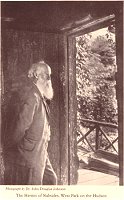
The Hermit of Slabsides, West Park on the Hudson
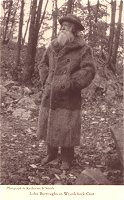
John Burroughs in woodchuck coat
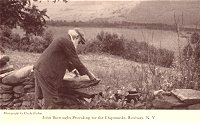
John Burroughs providing for the chipmunks
Roxbury, NY
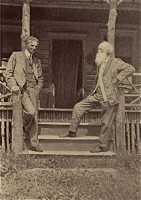
Henry Ford and John Burroughs at Woodchuck Lodge
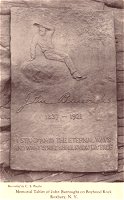
Memorial tablet to John Burroughs on Boyhood
Rock, Roxbury, NY |
(Note: Earlier versions of this essay first saw
print in March/April 1982 edition of THE CONSERVATIONIST March/April
and in the Summer 2001 edition of the Mountain Top Historical
Society's HEMLOCK.)
Early in 1873, John Burroughs purchased a
nine-acre farm on the banks of the Hudson River at West Park
(Esopus), NY, ninety miles above Manhattan. At the time he was
thirty-six years old and had barely begun to write nature essays. The
farm, which he named Riverby ("by-the-river," but
pronounced "riverbee") was more expensive than he would
have liked, but the setting of the place was one that appealed. In
addition, the farm lay within a day's ride of his family home - the
dairy farm on which he'd been raised - at Roxbury, in the Catskills.
Life at Riverby proved ideal for Burroughs. For
nine years he had worked a desk-job at the Federal Treasury in
Washington, DC. Now he wanted a way to make a living that would leave
him leisure in which to also make books. Tending to his fields,
Burroughs could at the same time contemplate the wide river spread
out before him. A short walk brought him to a hemlock woods a mile or
two inland. Black Creek, a small stream he would come to love, ran
through the trees.
Unlike his first writings, Burroughs's
subsequent work of over twenty volumes would need not be written at a
desk facing the iron wall of a vault in the Treasury Department. Also
unlike his first essays, all his best outdoor writing would
henceforth be infused with images of nature as found on familiar
terrain - the Hudson River Valley and Burroughs's adjacent natal
region of the Catskills. Like Thoreau, who said he had "travelled
widely in Concord," Burroughs would in future always seem
content to travel widely in Ulster and Delaware Counties.
"Nature comes home to one most when he is
at home," he wrote in 1886, "the stranger and traveler
finds her a stranger and traveler also. One's own landscape comes in
time to be a sort of outlying part of himself; he has sowed himself
broadcast upon it, and it reflects his own moods and feelings; he is
sensitive to the verge of the horizon: cut those trees, he bleeds;
mar those hills, he suffers."
Interestingly, although the Hudson Valley and
the Catskills provided the main fodder for Burroughs's nature notes,
the Hudson River itself - which flows through one, by the other, and
does so much to define both - never dominated his pen. In fact, of
all the essays Burroughs ever wrote, only one - "A River
View" in the 1886 volume SIGNS AND SEASONS - dealt with the
Hudson at any length. More often Burroughs based his essays in the
world of the hemlock woods inland from the river, on the banks of
Black Creek, or in the Catskills forests of his youth, to which he
always returned.
Why did Burroughs, in his published writings,
shun the beautiful river on which he had chosen, at the age of
thirty-six, to build his home?
In the book SPECIMEN DAYS, parts of which were
written while visiting at Riverby, Burroughs's friend Walt Whitman
described the scene of the Hudson as glimpsed from the Burroughs
farm. Whitman's pen especially captured the magic of the calm river
in evening: "The river at night has its special
character-beauties. The shad-fishermen go forth in their boats and
pay out their nets - one sitting forward, rowing, and one standing up
aft dropping it properly - marking the line with little floats
bearing candles, conveying, as they glide over the water, an
indescribable sentiment and doubled brightness ... the sloops' and
schooners' shadowy forms, like phantoms, white, silent, indefinite,
out there." Whitman describes an eminently attractive scene: one
that beckoned hourly to Burroughs as he worked in his fields.
Nevertheless, throughout the journals of John Burroughs, one finds
nary a trace of the river.
In one rare moment of homage to Father Hudson
- this dated 10 October 1883 - Burroughs wrote to chronicle: "
... our matchless October day -- the ripest best fruit of the weather
system of our clime ... The early frosts are over, and the fall heats
are passed, and the days is like a full-orbed mellow apple just clinging
to the bough. The great moist shadows of the opposite shore I see through
the tender medium of sunlit haze ... A sloop goes drifting by, part
of her sail a blue shadow. I can hear the ripples of the water about
her bow. The day is retrospective, and seems full of tender memories."
The image, observed "through the tender
medium of sunlit haze," sounds almost like a scene from a work
of the Hudson River School. As described by Carl Carmer, the chief aim
of such Hudson River artists as Asher Durrand and Thomas Cole was to
depict, as near to reality as possible, the Creator's greatest natural
handiworks. The selection of sublime subjects made these paintings appear
romantic in sentiment and majestic in scope despite the rule of most
Hudson River artists that natural beauty be recreated exactly as it
was, with no attempt by mortal hands to improve upon the artistry of
God. The point was to make whoever viewed the work of art feel, as Carmer
has written, "awed and humble in the presence of divine sublimity."
|
|
Offering some of the most sweeping and awe-inspiring
vistas in the world, the Hudson was well suited to be the home of such
a school of painting. What attracted the Hudson River painters, however,
in turn repelled John Burroughs.
Unlike the Hudson River painters, John Burroughs's
artistic aim was not to make his readers feel diminished by, or in anyway
set apart from, the whole of nature. Quite the contrary. As he wrote
in the 1877 volume BIRDS AND POETS, "... when I go to the woods
or fields, or ascend to the hilltop, I do not seem to be gazing upon
beauty at all, but to be breathing it like the air. I am not dazzled
or astonished; I am in no hurry lest it be gone. I would not have ...
the banks trimmed, or the ground painted. What I enjoy is commensurate
with the earth and sky itself. It clings to the rocks and trees; it
is kindred to the roughness and savagery; it rises from every tangle
and chasm; it perches on the dry oak stubs with the hawks and buzzards
... I am not a spectator of, but a participator in it. It is not an
adornment; its roots strike to the centre of the earth."
Burroughs sought, and found, the universal in
the local; he likewise wished to discover the cosmic as revealed by
the most simple and understated aspects of the natural world. In the
final analysis, the Hudson as natural phenomena impressed him no more
than did the miracle of a hummingbird's nest. In other words, what
Burroughs wanted from nature was something more complex and
interesting than the mere picturesque. Nature's grandest
demonstrations - the panoramas of the Hudson or the Grand Canyon, the
geysers of the American West, and the glaciers of Alaska - never
impressed him more favorably than did the Catskills trout streams he
had frequented so earnestly in both his youth and maturity. Indeed,
he much preferred the latter.
Thus, when Burroughs eventually came to write
about the Hudson in "A River View," he used the opening
paragraphs to explain exactly why the river did not attract him.
"A small river or stream flowing by one's door," he wrote,
"has many attractions over a large body of water like the
Hudson. One can make a companion of it, he can walk with it and sit
with it, or lounge on its banks, and feel that it is all his own. It
becomes something private and special to him. You cannot have the
same kind of attachment and sympathy with a big river; it does not
flow through the affections like a lesser stream. The Hudson is a
long arm of the sea and has something of the sea's austerity and
grandeur. I think one might spend a lifetime on its banks without
feeling any sense of ownership in it, or become at all intimate with
it; it keeps one at arm's length."
Burroughs returned to this theme in 1895 when
explaining why he'd built a small cabin retreat - Slabsides - a few
miles to the west of Riverby. "Friends have asked me," he
wrote, "why I turned my back upon the Hudson and retreated to
the wilderness ... To a countryman like myself, not born to a great
river or an extensive water-view, these things, I think, grow
wearisome after a time. He becomes surfeited with a beauty that is
alien to him. He longs for something more homely, private, and
secluded. Scenery may be too fine or too grand and imposing for one's
daily or hourly view. It tires after a while. It demands a mood that
comes to you only at intervals. Hence it is never wise to build your
house on the most ambitious spot in the landscape. Rather seek out a
more humble and secluded nook or corner, which you can warm with your
domestic and home instincts and affections. In some things the half
is often more satisfying than the whole. A glimpse of the Hudson
River between hills or through openings in the trees wears better
with me than a long expanse of it constantly spread out before me."
Burroughs retreated even further from the
Hudson when, as of 1910, he took to spending his summers in a cottage
- Woodchuck Lodge - on his boyhood farm in Roxbury. Here he came full
circle, returning to the countryside of his youth for what would
prove to be the last ten summers of his life. He relished the
landscape here, and did not seem to miss the Hudson at all. Writing
in an essay entitled "The Circuit of the Summer Hills," he
told his readers that at Roxbury: "The peace of the hills is
about me and upon me; the leisure of the summer clouds, whose shadows
I see slowly drifting across the face of the landscape, is mine. The
dissonance and the turbulence and the stench of cities - how far off
they seem! The noise and dust, and the acrimony of politics - how
completely the hum of the honey-bee, and the twitter of the swallows
blot them out! In the circuit of the hills the days take form and
character ... The deep, cradle-like valleys, and the long flowing
mountain-lines, make a fit receptacle for the day's beauty ... The
valleys are vast blue urns that hold a generous portion of lucid hours."
The view of his old age was the view of his
childhood. It stopped at the brow of his hill. And that was far
enough: the half always more satisfying than the whole.
=====
EDWARD J. RENEHAN JR.
erenehan@yahoo.com
http://edrenehan.com/
Back to the John Burroughs Page
|







